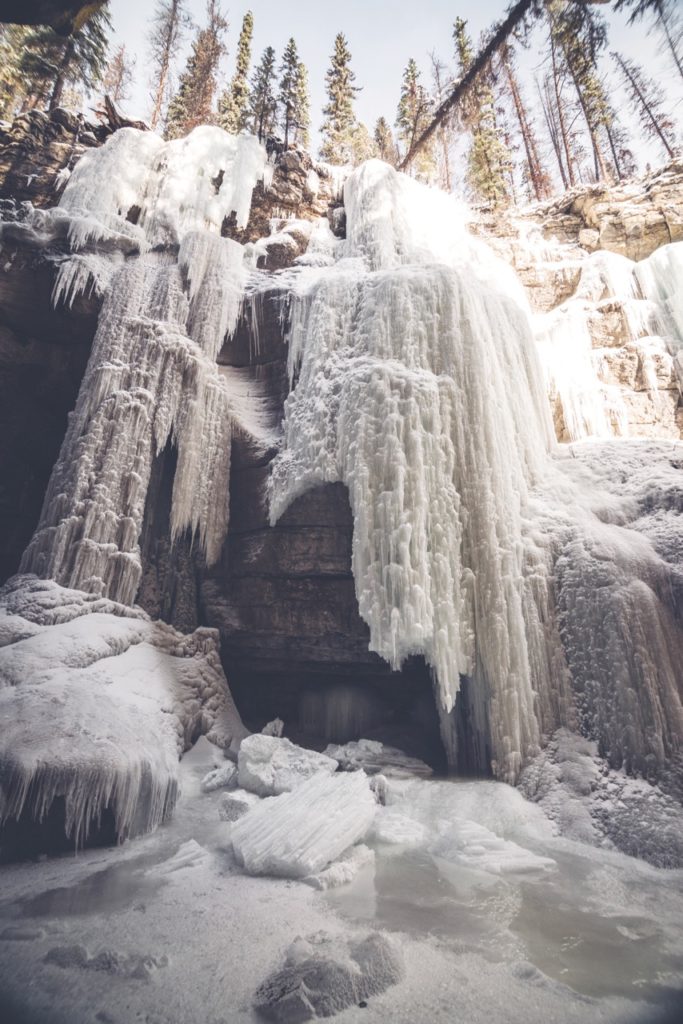Walking into the Maligne Canyon on a frigid winter day feels like stepping into another world.
As the canyon’s walls rear up above you, pale blue ice pours back down, a cascade of water quite literally frozen in time. This beguiling paradox lends the place an otherworldly allure: gargantuan ice structures, unquestionably solid, nevertheless seem to flow over the canyon’s edges and along its narrow base.
But this seeming contradiction is no mirage. The ice in the Maligne Canyon, much like that of the glaciers, is a dynamic and ever-changing thing. Recently, as the mild winter has given way to a sudden and deep cold snap, that dynamism has been on full display.

Entering the canyon from the downstream side, a narrow hallway of rock leads to a tiered icefall known as “The Angel.” Here, despite temperatures in the minus thirties, liquid water flows overtop of the thick layer of ice that encases the canyon walls. The buildup of ice at the base of the icefall constricts the flow of water, resulting in a pronounced cone from which a steady stream squirts forth like a fountain.
Venturing further up the canyon, what two weeks ago was a solid foundation of translucent ice is now a semi-permeable mélange of ice and water, passable in some places, but deep enough to swallow your boot in others. Massive curtains of blue ice dangle ominously from overhung walls to the right. Then, as you pass through a slight constriction, The Queen makes her appearance.

Anchored on a car-sized boulder at its base, The Queen stands tall as the proudest, most imposing ice feature in the Maligne Canyon. Her 25-metre column of complexly-featured ice plummets from the rim, while a bulge two-thirds of the way up her expanse produces sections that tip past the vertical plane.
For decades, The Queen has been a favourite training ground for ice climbers preparing their bodies and minds for the classic ice climbs that line the Icefields Parkway. For climbers keen to test their mettle on test pieces like “Curtain Call,” “Polar Circus” and “Ice 9,” there can be few more ideal venues for training laps than this Maligne marvel.

But even the mighty Queen is not immune to the ever-shifting forces that shape the canyon’s walls. Sometime during the wee hours of February 7—as the temperature plummeted and the ice grew more brittle—two massive curtains that had formed like wings on either side of The Queen slipped loose of their moorings on the overhung rock walls above and came crashing down onto the canyon floor. Their remnants now lay like gnarled tombstones at The Queen’s foot, reminders of the awesome power that hangs above.

Continuing up further still, another reminder of the canyon’s dangerous dynamism soon comes into view. A collapsed ice shelf reveals a gaping cavern extending into the dark and frigid depths of the canyon floor. When the first sustained cold weather arrives in the fall, the water that runs through the canyon begins to freeze. Soon, however, the flow of water coursing through underground karst features from Medicine Lake dissipates. As a result, gaps form between the surface ice and the canyon floor. In high water years, this can mean that ice walkers in the canyon are, in fact, suspended several meters above the ground by a temporarily fixed layer of temporarily solid water.

In recent years, Maligne Canyon ice walks have become one of the most popular winter tourism activities in Jasper. On any given day, you can expect to find several groups of helmet-clad visitors scuttling along the canyon’s depths like so many penguins. Suitably awed by the gorge’s grand walls, they struggle to maintain their micro-spiked traction while their guides shepherd them past the canyon’s pitfalls. Ice climbing, too, has enjoyed a recent resurgence in popularity. More and more Jasper climbers are seizing on the Maligne Canyon’s rare combination of superb, steep ice and easy accessibility.
As thousands of visitors to Jasper know, a short walk from the parking lot can reveal the dramatic beauty of the Maligne Canyon in winter. But those fortunate enough to make repeated visits into the depths of this magnificent feature will be witness to something still more profound: the power and majesty of these solid formations that exist in a continual state of flow.
Doug Olthof// thejasperlocal@gmail.com


